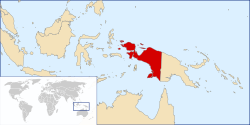Loading AI tools
Administrative body of Western New Guinea (1962–1963) From Wikipedia, the free encyclopedia
United Nations Administered West New Guinea refers to the period between 1 October 1962 and 1 May 1963 when Western New Guinea was administered by the United Nations Temporary Executive Authority (UNTEA) in accordance with in article two of the New York Agreement reached between the governments of the Netherlands and Indonesia in August 1962.
West New Guinea | |||||||||
|---|---|---|---|---|---|---|---|---|---|
| 1962–1963 | |||||||||
 Location of West New Guinea in Oceania | |||||||||
| Status | Subsidiary organ of the UN General Assembly[1] | ||||||||
| Capital | Hollandia[2] | ||||||||
| Common languages | Dutch English Papuan languages Austronesian languages | ||||||||
| Administrator | |||||||||
• 1962–1963 | Jalal Abdoh | ||||||||
| Historical era | Cold War | ||||||||
• Established | 1 October 1962 | ||||||||
• Disestablished | 1 May 1963 | ||||||||
| Currency | Dutch New Guinean gulden | ||||||||
| |||||||||
This was the first time in its history that the United Nations assumed direct administrative responsibility for a territory (as opposed to monitoring or supervising). The UN was responsible for promoting and safeguarding human rights at the national level. The United Nations would go on to undertake similar missions in Cambodia (UNTAC), Croatia (UNTAES), Kosovo (UNMIK) and East Timor (UNTAET).
Western New Guinea became the focus of a political dispute between the Netherlands and Indonesia following the recognition of the independence of the latter. The Indonesian side claimed the territory as its own while the Dutch side maintained that its residents were not Indonesian and that the Netherlands would continue to administer the territory as Dutch New Guinea until it was capable of self-determination.
In May 1959 a United States diplomat proposed a scheme for using a "a special United Nations trusteeship over the territory for a limited number of years, at the end of which time sovereignty would be turned over to Indonesia";[3] and in March 1961 the U.S. Embassy in Jakarta asserted "the Indos once contended that UN trusteeship would be anathema under any circumstances. Now, although they have not gone so far as to be willing to call a trusteeship a trusteeship, they talk in terms of "one or two years" of some kind of interregnum as being acceptable."[4] The Netherlands refused to directly transfer the colony to Indonesia and, with Operation Trikora underway, requested the UN dictate self-determination rights in 1962.[5] On 15 August, Indonesia and The Netherlands signed the New York Agreement, which promulgated a transfer via a temporary United Nations administration.
The United Nations General Assembly approved the agreement and accepted administration on 21 September in General Assembly resolution 1752.[6] The UN administration took effect on 1 October 1962.
The transfer of authority took place on 1 May 1963 and West New Guinea became a province of Indonesia known as West Irian (Irian Barat).[7] It was agreed that following the transfer of authority Elias Jan Bonai, a member of the New Guinea Council, would be appointed as the first Indonesian Governor.[citation needed] It later evolved into the present-day provinces of Papua, Southwest Papua, Central Papua, South Papua, Highland Papua and West Papua.
According to the New York Agreement, UNTEA could legislate, appoint government officials, and guarantee law and order. These permissions led to the establishment of a court system, a New Guinea Council and regional councils.[8] An official gazette was established on 1 October 1962.[9] During the seven-month transition period Dutch civil servants and officials were slowly recalled to the Netherlands and were replaced by, UN, local and Indonesian officials.
The New Guinea Council, first elected in January 1961, was reconvened by the administrator on 4 December 1962 and members took new oaths of office, swearing allegiance to UNTEA. The administrator had the power to appoint new members of the council to fill any vacancies that may arise. Eleven regional councils were also established.[10]
UNTEA was initially led by acting administrator José Rolz-Bennett of Guatemala from 1 October 1962 to 15 November, and then by Jalal Abdoh of Imperial Iran who served as administrator from 15 November 1962 to 1 May 1963.
The governments of the Netherlands, Indonesia and Australia established liaison offices in Hollandia.[11][12]
In addition to civil administration, the United Nations also had a peacekeeping role through a United Nations Security Force (UNSF). The maximum force strength was 1,500 infantry and 76 aircraft personnel. Pakistan, Canada and United States contributed personnel with Pakistan providing 1,500 troops and the United States and Canada contributing 60 and 16 air force personnel respectively.[13] The locally recruited Papuan Volunteer Corps, established by the Netherlands in 1961, was also placed under UNSF command.[11] The Force Commander for the UNSF was Said Uddin Khan of Pakistan.
Following the departure of Dutch police officers, Philippine officers were initially drafted in as an interim measure, before being replaced by Indonesian officers under UNTEA command.[11]
Nineteen postage stamps, as well as some postal stationery items, were issued by UNTEA. These were created by overprinting existing stocks of Netherlands New Guinea issues.[14] At the time packets of all stamps were sold at UN Headquarters by the United Nations Postal Administration and they remain readily available on the retail market.
Seamless Wikipedia browsing. On steroids.
Every time you click a link to Wikipedia, Wiktionary or Wikiquote in your browser's search results, it will show the modern Wikiwand interface.
Wikiwand extension is a five stars, simple, with minimum permission required to keep your browsing private, safe and transparent.